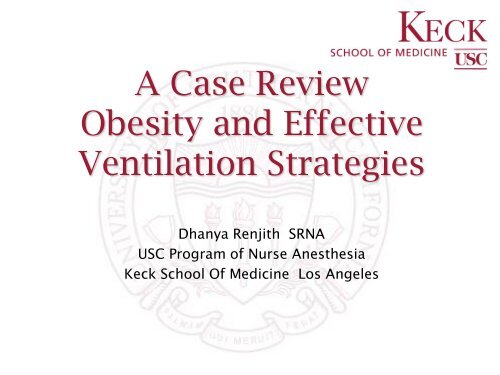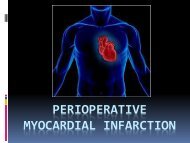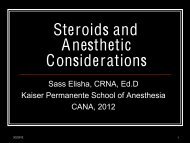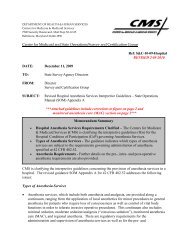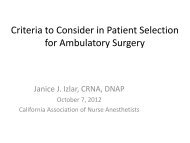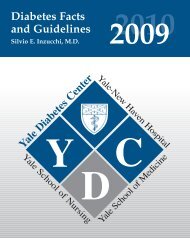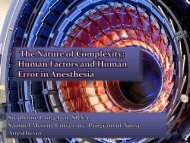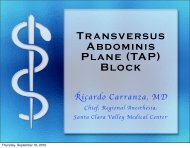A Case Review Obesity and Effective Ventilation Strategies
A Case Review Obesity and Effective Ventilation Strategies
A Case Review Obesity and Effective Ventilation Strategies
You also want an ePaper? Increase the reach of your titles
YUMPU automatically turns print PDFs into web optimized ePapers that Google loves.
A <strong>Case</strong> <strong>Review</strong><br />
<strong>Obesity</strong> <strong>and</strong> <strong>Effective</strong><br />
<strong>Ventilation</strong> <strong>Strategies</strong><br />
Dhanya Renjith SRNA<br />
USC Program of Nurse Anesthesia<br />
Keck School Of Medicine Los Angeles
Objectives<br />
<br />
<br />
Discuss the impact of obesity on ventilation<br />
during anesthesia<br />
Identify the role of ventilator settings during<br />
intra operative management of obese patients
<strong>Case</strong> Scenario<br />
42 year old female patient undergoing laparoscopic<br />
assisted Vaginal Hysterectomy<br />
5 feet 2 inches tall <strong>and</strong> weighs 205<br />
pounds/BMI=37.4 (IBW=50 kg/ ABW=67.3 kg)<br />
Stable vital signs – Room Air SpO 2 =97%<br />
No intrinsic or extrinsic lung disease<br />
<br />
Android distribution of fat<br />
Pre oxygenated with 100% oxygen, with PEEP of 5<br />
cm of H 2 O for 5 minutes; shoulder ramps used<br />
during intubation<br />
Easy intubation
Ventilator settings<br />
Volume control mode- Tidal Volume 600 /<br />
Respiratory rate 12 / I: E 1:2<br />
<br />
<br />
SpO 2 98%, PIP 18 cm of H2O, Plateau pressure<br />
15 cm of H 2 O; stable vital signs<br />
CO 2 insufflation- PIP increases to 34 cm of H 2 O<br />
– SpO 2 down to 95 %.
How will you ventilate
Respiratory Physiology in<br />
<strong>Obesity</strong><br />
<br />
<br />
<br />
<br />
<br />
<br />
Decreased compliance <strong>and</strong> increased resistance<br />
Shallow <strong>and</strong> rapid breathing - Increased work of<br />
breathing<br />
Decreased FRC/Decreased Vital capacity / Decreased<br />
Total lung capacity<br />
FRC less than closing capacity<br />
Anesthesia- 50% reduction of FRC in obese patients<br />
as compared to 20% in non obese<br />
Increased oxygen consumption <strong>and</strong> CO 2 production<br />
even at rest
Respiratory Physiology in<br />
<strong>Obesity</strong><br />
<br />
<br />
Increased cardiac output <strong>and</strong> minute ventilation<br />
Increased oxygen consumption – PaO 2 in<br />
morbidly obese patients is less than predicted<br />
for similarly aged non obese patients<br />
OSA (5% of obese patients)- hypoxemia ,<br />
hypercapnia, pulmonary <strong>and</strong> systemic<br />
vasoconstriction, polycythemia
During Anesthesia<br />
<br />
<br />
<br />
<br />
<br />
Supine position<br />
High elevation of diaphragm (due to increased<br />
visceral <strong>and</strong> abdominal fat )<br />
<strong>Ventilation</strong> perfusion mismatch<br />
Right to left shunting<br />
Hypoxemia
During Anesthesia<br />
(continued)<br />
Decreased compliance <strong>and</strong> increased resistance -<br />
Higher inflation pressures required for<br />
ventilation<br />
<br />
<br />
<br />
<br />
LMA vs. ETT<br />
Risks-aspiration / hypoventilation/hypoxemia<br />
Precludes the use of LMA<br />
Study that favors LMA for minor surgeries in<br />
obese
CT scan – normal <strong>and</strong> obese<br />
patient under anesthesia
<strong>Effective</strong> ventilation vs. prevention<br />
of injury<br />
<strong>Ventilation</strong> – SpO 2 , PaO 2 , PaCO 2 , ETCO 2<br />
Repetitive opening <strong>and</strong> closing of unstable lung<br />
units – cyclic stretch-------- INJURY<br />
<br />
Effects of injury- Neutrophil infiltration , rupture<br />
of alveolar bronchial attachment, formation of<br />
reactive oxygen / nitrogen intermediates, cell<br />
death ( necrosis <strong>and</strong> apoptosis), alteration in<br />
alveolar capillary barrier<br />
Up regulation of pro inflammatory mediators<br />
like TNF-α <strong>and</strong> interleukin 8 in rabbits given<br />
large TV <strong>and</strong> moderate hyperoxia
Modes <strong>and</strong> settings<br />
<br />
<br />
<br />
<br />
<br />
<br />
Volume Control/Pressure Control<br />
Pressure /volume / rate<br />
Peak inspiratory pressure / mean peak pressure<br />
Plateau pressure<br />
I:E ratio<br />
Use of PEEP
Peak pressure vs. plateau pressure
Volume Control Vs. Pressure<br />
Control<br />
<br />
<br />
<br />
<br />
<br />
<br />
<br />
BJA article – prospective study on 38 patients with<br />
BMI >35 – laparoscopic surgery<br />
Pressure control vs. Volume control<br />
Pressure Control – better tidal volume , PaO 2 ,lesser<br />
A-a gradient, lower PaCO 2<br />
Peak inspiratory flow was higher in pressure control<br />
(52 liter /sec vs. 41 liter/sec)<br />
Tidal volume at ½ inspiratory time 67 % in pressure<br />
control ventilation <strong>and</strong> 53% in volume control<br />
ventilation<br />
Downsides – In laparoscopic surgeries with<br />
trendelenberg position- High risk for endobronchial<br />
intubation<br />
And what happens when the surgeon deflates the<br />
abdomen
Volume control
Pressure control
PEEP<br />
In a meta-analysis of eight RCTs involving 330<br />
surgical patients, positive pressure ventilation with<br />
PEEP resulted in favorable effects on day 1<br />
postoperatively in terms of higher PaO 2 /FIO 2 <strong>and</strong><br />
lesser atelectatic areas, compared with mechanical<br />
ventilation without PEEP (or zero-PEEP, ZEEP)<br />
In morbidly obese patients 10 cm of H 2 O PEEP has<br />
been shown to reduce respiratory elastance <strong>and</strong> to<br />
improve oxygen exchange<br />
PEEP shown to increase esophageal sphincter<br />
pressures- reduces the risk of regurgitation<br />
Pressure Control with PEEP – studies
Recruitment Maneuvers<br />
<br />
Recruitment maneuvers – Peak inspiratory<br />
pressure of 40 cm Hg for 7-8 sec- increases<br />
lung volumes up to vital capacity<br />
ARS (alveolar recruitment strategy)- stepwise<br />
increase of PEEP/inspiratory pressures (e.g.,<br />
0/10, 5/15, 10/20, 15/25 cm H 2 O) over 8 to 10<br />
respiratory cycles<br />
Applying a continuous positive airway pressure<br />
(CPAP) over 10-30 s
Protective ventilation<br />
strategies<br />
<br />
<br />
Higher surgical risk (major abdominal, thoracic<br />
<strong>and</strong> cardiac surgery)-a protective ventilation<br />
strategy (V T 4-6 ml/kg Predicted Body Weight,<br />
PEEP with or without Recruitment Maneuver) -<br />
associated with a reduced expression of<br />
alveolar/ systemic inflammatory markers<br />
ARDS net study - Higher tidal volume vs. lower<br />
tidal volume
Back to the case<br />
Volume control mode- Tidal Volume 600 /<br />
Respiratory rate 12 / I: E=1:2<br />
<br />
SPO 2 98% , PIP -18, Plateau pressure 15- Vital<br />
signs stable<br />
CO 2 insufflation- PIP 34 – SPO 2 -95 %<br />
<br />
<br />
Switched to pressure control with pressure<br />
setting – 24 /RR-12<br />
TV -700s , rate 12 . SpO 2 98-99 <strong>and</strong> stable vital<br />
signs .
Summary<br />
<br />
<br />
<br />
Was the pressure control mode appropriate<br />
Alternatives<br />
A systematic approach is required
High peak pressure – Identify the cause<br />
Man Vs. Machine<br />
Man-bronchospasm<br />
Lung/pleura/chest wall<br />
patient-ventilator<br />
dysynchrony<br />
Machine-ventilator settings<br />
Circuit-kink, secretions<br />
ETT- Right main stem
Treat the cause / Change the settings<br />
Increase I:E ratio<br />
Pressure control<br />
PEEP<br />
Sigh mode<br />
Recruitment maneuver<br />
Consider changing the position the patient<br />
No improvement – Communicate with the<br />
surgeon- Time for laparotomy
References:<br />
<br />
Morgan GE, Mikhail MS, Murray MJ (2006) Clinical<br />
Anesthesiology (4 th ed.). Newyork, NY: McGraw-Hill<br />
<br />
Corrie KR et al. The effect of obesity <strong>and</strong> anesthetic<br />
maintenance regimen on postoperative pulmonary<br />
complications. Anes <strong>and</strong> Analg. 2011;113(1)4-6<br />
<br />
Cadi P et al.Pressure-controlled ventilation improves<br />
oxygenation during laparoscopic obesity surgery<br />
compared with volume-controlled ventilation. Br J Of<br />
Anes. 2008; 100 (5):709–716<br />
<br />
Barash, P.G, Cullen, B.F & Stoelting R.F. (2009). Clinical<br />
Anesthesia(6 th ed.) Philadelphia PA: Lippincott Williams<br />
<strong>and</strong> Wilkins
References:<br />
<br />
Pelosi P <strong>and</strong> Greforetti C. Perioperative management of<br />
obese patients. Best Practice & Research Clinical<br />
Anaesthesiology;(2010)211–225<br />
<br />
Hans GA et al. Pressure-controlled <strong>Ventilation</strong> Does Not<br />
Improve Gas Exchange in Morbidly Obese Patients<br />
Undergoing Abdominal Surgery. Obes Surg(2008);18:71–<br />
76
Questions


